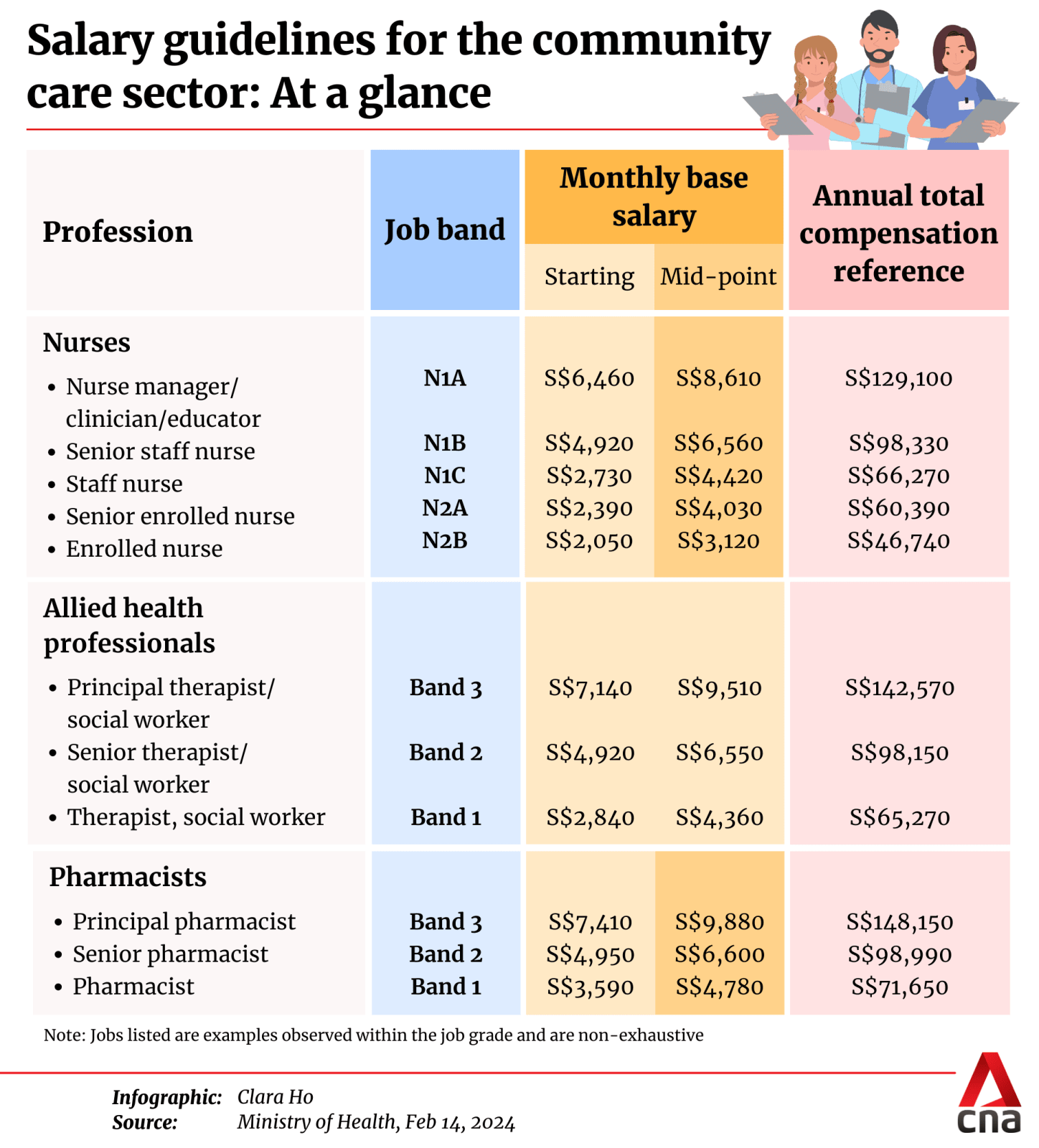Salary guidelines helpful but 'crucial' to address other factors to retain, attract workers: Community care providers
Besides wages, other factors that people consider when joining the community care sector are workload, opportunities for career progression and recognition.

A nurse with an elderly patient. (File photo: iStock/Kiwis)

This audio is generated by an AI tool.
- The Health Ministry has published salary guidelines for the community care sector to help retain and attract talent
- Organisations welcome the guidelines, with one calling it a "timely and robust overview"
- Besides salaries, other factors such as workload and growth opportunities need to be addressed to ensure people stay in the healthcare industry, says one provider
SINGAPORE: Salary guidelines aimed at attracting and retaining talent in the community care sector are a good start, but providers said other measures are needed.
These include alleviating employees' workloads, increasing opportunities for job progression and having greater recognition for their efforts.
The Ministry of Health (MOH) on Feb 14 released salary guidelines for the community care workforce – the first time it has published wage guidelines for sectors under its purview.
Aimed at improving transparency and helping community care organisations offer competitive salaries, the guidelines apply to all jobs in the sector. The workforce in the sector has grown from 16,500 in 2020 to more than 18,000 last year.
In April last year, Health Minister Ong Ye Kung said that improving and expanding the community care sector would be MOH’s next priority as Singapore’s population ages. By 2030, nearly 25 per cent of Singaporeans will be aged 65 and above.
SHORTAGE OF STAFF "A PERENNIAL CHALLENGE"
The nationwide demand for qualified nurses and a shortage of care staff is a “perennial challenge”, said Ms Kok Ee Lan, head of human resources at NTUC Health.
The organisation has more than 1,500 staff members who serve over 10,000 people through its eldercare services, making it one of Singapore’s largest eldercare providers.
Citing "tight manpower resources" in the sector, Ms Kok said NTUC Health has stepped up efforts to recruit and retain staff.
These include supplementing its workforce with part-time employees and engaging institutes of higher learning for internships where students get exposure.
Mr Andy Lee, divisional director of seniors’ community services at Thye Hua Kwan Moral Charities, said that “increased expectations” placed on healthcare workers add to their stress levels.
This means the “probability of burnout is high”, he added.
Several providers told CNA they have introduced measures to address this, including offering flexible work arrangements.
Ms Gillian Tee, CEO and co-founder of care service provider Homage, said it is “crucial” to address the factors – other than salaries – that can enable people to enter and remain in the healthcare industry.
Homage has a network of more than 10,000 trained care professionals and delivers over 1 million hourly care sessions annually.
“With more control over their schedule, healthcare professionals can still provide their unique caregiving skills without burning themselves out, resulting in better career longevity,” she said.
“Such arrangements also cater to individuals who may not be able to commit to full-time roles but have the heartbeat, motivation and skill sets to deliver care.”
NTUC Health said it supports employees who have varied commitments and needs by offering flexible working hours, part-time employment and a choice to work in any of its locations across Singapore.
It has partnered with the Agency of Integrated Care (AIC) to pilot the Community Care Job Redesign initiative, which looks at how they can make selected roles in the sector attractive to fresh school leavers or mid-career switchers, said Ms Kok.
CHALLENGING WORK
Some community care jobs involve looking after someone constantly. Annie (not her real name) has been a live-in caregiver for about six years and she takes care of patients in their homes.
The round-the-clock caregiving means there are times she does not get much sleep, but it is not fatigue that is the most difficult part of her job.
Many caregivers struggle with the challenge of dealing with their patients’ families, she said.
“If it’s the patient and you only, it’s quite okay, we can manage each other,” she said.
Annie said she treats her patient like her own family and knows of other caregivers who do the same. She feels content in her work because she gets on well with her patient and their family.
But she has heard of others who have left the profession due to the stress of dealing with their patient’s relatives. Annie believes this aspect of the job may keep some away.
Ms Felicia See, head of human resources at Home Nursing Foundation (HNF), said: “Community care sector employees typically feel that the work that they are doing is not something that the public will understand and empathise with.”
The profession requires “independent, autonomous practice” in community care and working in patients’ home environments, said Professor Liaw Sok Ying, head of the Alice Lee Centre for Nursing Studies at the National University of Singapore (NUS).
This “may be perceived as challenging” for nursing students and newly graduated nurses, she added.
While there is a general preference among most nursing students and new graduates for “fast-paced environments” – such as intensive care units or emergency departments – students have acknowledged the growing importance of developing the community care sector.
In a study conducted to look at the perceptions of community care and placement preference among NUS nursing students, about 30 per cent of them prefer placements in community care settings.
The university helps students to better prepare by focusing on community healthcare aspects, including management of chronic diseases, health promotion, population health and social determinants.
GROWTH OPPORTUNITIES, GREATER RECOGNITION
Prof Liaw told CNA that opportunities for professional development play a critical role in attracting and retaining talent in the sector.
“To develop a skilled and diverse community care workforce, it is important to have clearly defined career developmental tracks in community nursing, such as the progression as an advanced practice nurse and opportunities for nursing education progression.”
Several providers said people look out for these growth opportunities when considering jobs in the sector.
Ms Tee said community care jobs need to be comparable to jobs in other sectors, and organisations have to be able to “map well to what job seekers value”.
This includes providing a career pathway that leads to ongoing advancement and progression.
MOH said that beyond the salary guidelines, it has also provided support for upskilling through scholarships and training awards.
The Community Care Manpower Development Award (CCMDA) helps staff pursue further studies, including degree programmes and post-graduate qualifications.
Another award, the Community Care Excellence Award (CCEA) recognises outstanding staff contributions within the sector.
Last year, more than 140 staff members received the CCMDA and 378 people were given the CCEA.
Ms Tee also raised the need for greater recognition and respect for community care workers.
“While designated days like Nurses Day and Allied Health Day celebrate healthcare workers, there is a need for broader appreciation and respect from patients, families, and the public for the daily contributions of healthcare professionals,” she added.
SALARY GUIDELINES A GOOD START
Compensation is still a crucial consideration for people entering and staying in the sector. The guidelines will help providers remain competitive, the organisations told CNA.
Ms Kok said that NTUC Health welcomes the guidelines in light of the tight manpower resources in the sector.
“The recommended guidelines by MOH provide a timely and robust overview of industry standards,” she said, adding that they would provide a “valuable framework” for its staff salaries.
The guidelines give the recommended starting and mid-point monthly base salary for the job band and position, as well as the median annual total compensation.
For example, a full-time enrolled nurse can expect to receive a starting monthly base salary of S$2,050 (US$1,520), which will increase to S$3,120 at the mid-point of their job band after gaining more experience.
Monthly base salaries exclude bonuses, allowances, and other benefits that may vary from organisation to organisation. The actual salaries of individual staff members may also vary based on their relevant experience and work performance.

Homage’s Ms Tee said the guidelines are helpful, but salaries are not the only factor when people decide whether or not to join the sector.
“We see the guidelines to be reflective of market ranges as a whole for full-time positions," she added.
"Other considerations that can play a role in influencing the benchmarks would be if the position is a flexible, part-time or casual one as opposed to permanent roles."
The salary ranges for allied health professions – such as occupational therapists or radiographers – and administrative staff could be higher, said HNF’s Ms See, adding that this group could be “better supported”.
There has been a 25 per cent increase in some allied health professions in Singapore from 2019 to 2023 amid growing demand, said Senior Parliamentary Secretary for Health Rahayu Mahzam in parliament on Tuesday (Feb 27).
She added that the attrition rate of allied health professionals in the community care sector fell from 17.7 per cent in 2018 to 11.3 per cent in 2022 – an opposite trend to the attrition rate in the public healthcare sector.
Mr Lee said the guidelines provide “a level of transparency” for organisations and their employees.
“The challenge however will be the communication with employees as it intertwines with pay strategy, pay progression and market forces, but this is an exercise that Thye Hua Kwan Moral Charities is ready to work on,” he added.
Prof Liaw also believes that the guidelines serve as an important benchmark for organisations in the sector to remain competitive.
“It is a move that enhances the acknowledgement of the profession of community nurses, and it is certainly an important step towards attracting and retaining talent,” she said.
MOH announced last week that nurses will receive up to S$100,000 under a new retention scheme.
Publicly funded community care organisations can apply to participate in the scheme. They will need to co-fund the awards, with most of the funding coming from the government.


















